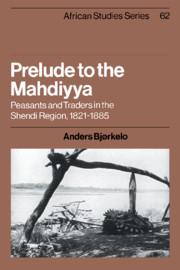Book contents
- Frontmatter
- Contents
- Figures
- List of maps
- List of tables
- Preface
- Acknowledgements
- Abbreviations
- Weights and measures
- The Sudan in the nineteenth century
- Introduction
- 1 The Ja'alī Kingdom of Shendi and its destruction
- 2 Shendi's economy on the eve of the Turkiyya
- 3 The Ja'aliyyīn under Turkish administration
- 4 The transformation of agriculture
- 5 Taxation
- 6 The transformation of commerce
- 7 Conclusion: dispersion and return
- Appendix: Three contracts from the archive of 'Abd Allāh Bey Ḥamza
- Notes
- Sources and bibliography
- Index
- OTHER BOOKS IN THE SERIES
2 - Shendi's economy on the eve of the Turkiyya
Published online by Cambridge University Press: 31 October 2009
- Frontmatter
- Contents
- Figures
- List of maps
- List of tables
- Preface
- Acknowledgements
- Abbreviations
- Weights and measures
- The Sudan in the nineteenth century
- Introduction
- 1 The Ja'alī Kingdom of Shendi and its destruction
- 2 Shendi's economy on the eve of the Turkiyya
- 3 The Ja'aliyyīn under Turkish administration
- 4 The transformation of agriculture
- 5 Taxation
- 6 The transformation of commerce
- 7 Conclusion: dispersion and return
- Appendix: Three contracts from the archive of 'Abd Allāh Bey Ḥamza
- Notes
- Sources and bibliography
- Index
- OTHER BOOKS IN THE SERIES
Summary
Contemporary descriptions of Shendi prior to the Turkiyya survive only for the years 1772, 1814, and 1821–2, but together they offer a vivid picture of the town and the market. Earlier travellers except perhaps David Reubeni in 1523, seem to have crossed the Nile further south, usually at QarrI where there was a quarantine station on the west bank.2 De Maillet's reports from 1692 onwards, as well as the accounts left by Poncet, Krump, Brevedent and other missionaries, doctors or ambassadors travelling around 1700 all show that the caravans left the Nile in the Manfalut/Aysut region in Egypt. After passing along the valley of al-Wah (Ar. ‘the oasis’), they reached the oasis of Sallma, where the Dar Fur caravan turned south-west and the Sinnar caravan turned south-east and reached the Nile at Mushu. The caravans then passed by (Old) Dongola on the east bank. At al-Dabba, Ambuqol or Kurti they left the Nile again and crossed the Bayucja to Dirayra opposite Wad Ban al-Naqa. Following the Nile on the west bank, they then crossed at QarrI near the Sixth Cataract.
Qarrī was the seat of the 'Abdallāb mānjil or governor of the northern Funj province. Caravans from Egypt had to pay customs there, usually in luxury items and in cash. Those who were not jallāba (sing, jallāb or jallābl), itinerant or caravan traders, of the king of Sinnar, were thoroughly searched.
About seventy years later, Bruce noted that there had been a second crossing point at Dirayra in Dār al-Ja'aliyīn, but the insecurity of the area had made it unattractive.
- Type
- Chapter
- Information
- Prelude to the MahdiyyaPeasants and Traders in the Shendi Region, 1821–1885, pp. 15 - 33Publisher: Cambridge University PressPrint publication year: 1989



